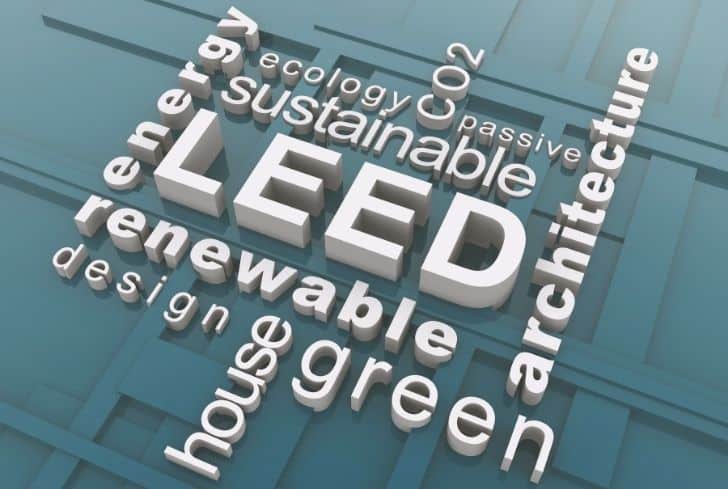LEED Certification: Why Do You Need it and Process to Apply For it

The demand for green construction and sustainable buildings is growing across the globe. The World Green Building Trends Smart Market Report indicated a 47% increase in green projects by 2021. The need for encouraging sustainable practices and improving occupant health and wellbeing has convinced property managers and environmental legislation bodies to formulate building rating programs. One such program is LEED certification.
In this article, we define LEED Certification, why it is needed, and go over how to apply and achieve LEED certification.
What is LEED?
LEED stands for Leadership in Energy and Environmental Design. It is a globally recognized green building rating program that assesses several metrics including,
- responsible land use
- building design and interior fit-outs
- energy savings
- water efficiency
- indoor environmental quality
- reduction of CO2 emissions
- access to public transportation and more.
The LEED program operates under the umbrella of the U.S. Green Building Council (USGBC), a non-profit organization that promotes prosperous, healthy, and resilient communities through sustainable buildings.
Since its inception in 1994, LEED has become an industry standard for excellence in sustainability. The goal of the LEED certification program is to motivate real estate professionals, engineers, interior designers, landscape architects, construction managers, corporate executives, and government officials to step up the green game all while improving company profitability and human well-being.
The LEED certification program consists of a four-tiered credit-based system. Based on the total points earned, buildings are awarded,
- Basic LEED certification: buildings with 40 – 49 points
- LEED Silver certification: buildings with 50 -59 points
- LEED Gold certifications: buildings with 60-79 points
- LEED Platinum certification: buildings with 80 or more points
Why Do You Need LEED Certification?
LEED certification is beneficial for builders and developers, the occupants, and the environment.
For Builders and Architects
Green buildings are having a moment. Recent studies showed that there’s a preference bias for “environmentally friendly” or “green” buildings among buyers.
Having a LEED certification will enhance your company’s brand value and credibility and establish you as a leader in green building. Because green buildings are more positively perceived and purchased nowadays, construction companies can charge higher lease rates and rentals.
The operational cost for green buildings is comparatively less. The usage of water and energy are fewer. They also generate less waste, enabling us to save huge in terms of waste management and maintenance.
For Building Occupants
Internal environments in green buildings are safer and healthier. Occupants can enjoy the perks of better indoor air quality, lighting support, and thermal support – all without increasing carbon footprint.
Studies show that green buildings reduce sick time and increase productivity among working professionals. Natural light, good ventilation, and the absence of volatile organic compound (VOC) emissions mean happier and healthier workplaces.
LEED certification for schools and healthcare centers helps foster an indoor environment that supports occupant health.
For the Environment
LEED-certified buildings are more energy and resource-efficient. Using geothermal, wind and solar energy at homes will cut back the amount of carbon dioxide emissions polluting our ozone layer.
LEED-certified buildings consume 11% less water and consume 25% less energy than conventional non-green buildings.
LEED-certified homes not only use recycled materials, but they also receive them from sustainable supplies. Green building materials (bamboo, reclaimed timber, for example) are as renewable as they are sustainable. That means less carbon footprint and less damage to the environment.
LEED Certification Checklist
There are 9 ways to earn LEED certification points that fall within six categories. The six 6 main categories on the LEED Certification checklist are,
- Location and Transportation: Consider potential environmental effects when choosing the site for building projects. When graded on location, points are based on where the project is located, it’s proximity to public transportation, green bicycle facilities, and reduced parking footprint.
- Water Efficiency: Credits are given for limited water use (both inside and outside buildings), no irrigations on-site, and a water metering system. 1-2 points are given for cooling tower water use as well. 6-15 points can be earned for improved water management.
- Energy and Atmosphere: This category is crucial as it focuses on effective energy management. Projects can earn these points by adding more renewable and clean power sources. For example, solar panels, wind turbines, and hydroelectric systems.
- Material Selection: Whether you’re building from scratch or renovating an old building, choose an eco-friendly way to score points in this category. Choose renewable, natural materials or simply reuse or recycle foundation structure materials to earn 4 points in this category. By implementing storage locations for recyclable materials, a facility can earn 3-8 points.
- Indoor Environmental Quality: Another heavily evaluated parameter in LEED certification. You can earn points through natural lighting, enhanced thermal comfort, green cleaning methods, minimal pollution, integrated pest management, and effective occupant comfort survey systems. A successful indoor environmental practice would grant 3 points.
- Innovative Design: In this category, buildings are evaluated for their innovative green building strategies. The credits and points given for this category are more flexible and demands out-of-the-box ideas to implement.
Is LEED Certification Mandatory?
Though each country has its own certifications to ensure sustainable building practices, LEED has expanded outside of the U.S., and today, they have more than 165 participant countries and territories. According to USGBC, LEED has certified close to 210 million gross square meters of space.
In the U.S, LEED certification is mandatory for all new federal government construction projects and renovations. According to the US General Services Administration, all new construction and renovation projects should have at least LEED Silver certification and requires these projects to achieve LEED Gold certification after reviews.
How to Apply For LEED Certification?
Interested in pursuing the current LEED v4.1 certification? You’ll need to move through the steps below:
The first step is to choose the rating system your facility or project comes under:
- Building Design and Construction
- Interior Design and Construction
- Operations and Maintenance
- Residential
- Cities and Communities
- Recertification
In each of these systems, there are categories such as Location & Transportation, Sustainable Sites, Water Efficiency, Energy & Atmosphere, Materials & Resources, Indoor Environmental Quality, and Innovation.
Now comes the application process. Several parts of LEED application are,
1. Project Registration
Before you begin the online application, ensure that your project meets all of the minimum requirements: comply with environmental laws, have reasonable site boundaries, it is a complete and permanent building, comply with minimum occupancy requirements and minimum building area to site ratio, and commit to sharing whole-building energy and water usage numbers.
Register your project online with the GBCI, Green Business Certification Inc. All registrations are done online, and it establishes the point of contact between the project and the GBCI.
2. Application
Once you are registered, the next step is compiling and submitting appropriate documentation for project review.
You will identify LEED credits to pursue and assign them to team members. You will then gather information, perform calculations and analysis, and prepare documentation that demonstrates your achievement of the prerequisites. GBCI recommends double-checking each data to make sure the information is entered accurately and consistently.
- Some characteristics of high-quality submissions include:
- Only required documentation is submitted
- Clear and intuitive labels on file attachments
- Highlighting of relevant prerequisites of the submission
- Detailed narratives and project-specific conditions
3. Review
After successful submission and payment, the Green Building Council will conduct a thorough technical review. The review varies depending on the scale of the project and the certification goals.
- Preliminary Review: Typically, this phase is to ensure that the application is complete or to request additional documentation. If the applicant is satisfied with the initial review results, then the certification process moves forward.
- Final Review: Applicants can appeal the preliminary review in this stage. This is the opportunity to submit supporting documents requested during the preliminary review. Edits can also be made at this point.
- Supplemental (Appeal) Review: If final review results aren’t satisfactory, then applicants can request a supplemental review. This comes with additional charges, which usually depend on the nature of the project and the changes made during the final review.
If all terms and results are satisfactory, send acceptance notice or, appeal for another supplemental review. There are no limits for appeals.
4. Certification
Next up is collecting the official LEED certification. The degree of achievement will be either LEED Certified, LEED Silver, LEED Gold, or LEED Platinum.
All LEED-certified projects come under ‘public projects’ and are accessible to anyone who searches the LEED projects directory. Each entry in the directory will have details such as certification level, total points earned, project type, date of registration, and date of certification.
Opting out of the directory is a personal choice.
Is There Any Downside to LEED Certification?
Theoretically, there is no downside to LEED. Building a thoughtfully-designed, sustainable green building is a good thing, no matter what. The criticism of LEED is that since it is point-based and covers a wide range of development area, chances of extorting the system is high. Another concern is that LEED buildings do not always run as efficiently as they were supposed to be once they are occupied.
References:
https://www.sciencedirect.com/science/article/pii/S036013231630508X
http://www.josre.org/wp-content/uploads/2012/09/Green_Buildings_Productivity-JOSRE_v1-41.pdf






